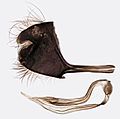Eriocrania sangii
| Eriocrania sangii | |
|---|---|

| |
| Scientific classification | |
| Domain: | Eukaryota |
| Kingdom: | Animalia |
| Phylum: | Arthropoda |
| Class: | Insecta |
| Order: | Lepidoptera |
| Family: | Eriocraniidae |
| Genus: | Eriocrania |
| Species: | E. sangii
|
| Binomial name | |
| Eriocrania sangii (Wood, 1891)
| |
| Synonyms | |
| |
Eriocrania sangii, the large birch purple,[1] is a moth of the family Eriocraniidae found in Europe and described by John Henry Wood in 1891. The moth can be found flying in sunshine around birch trees and the larvae feed on birch leaves.
Description
[edit]The wingspan is 9–14 mm. Edward Meyrick gives this description: head whitish-grey-ochreous, more or less mixed with dark fuscous. Antennae 1/2. Forewings elongate, bronzy-purple, with more or less numerous pale shining golden irregular spots: a subtriangular pale golden dorsal spot before tornus, reaching half across wing; cilia bronzy-grey, on dorsal spot ochreous-whitish; 9 absent. Hindwings bronzy-grey, towards apex purplish-tinged. Larva grey; head black, centre and mouth brown; 2 with two groups of black spots: in brownish blotch in leaves of birch. The moth can be found flying in sunshine, around birch trees, in March and April. In dull weather they rest on twigs.[2][3]
- Ovum
Eggs are laid in a leaf bud of birch.[3]
- Larvae
The grey larvae mine the leaves of birch (Betula species). The mine starts as a short gallery, close to a leaf margin and develops into a large, white, full depth blotch. Frass is in long threads. The leaf mines can be found from the end of March until May and when vacated, the mine shrivels and withers away.[4] Larvae feed on downy birch (Betula pendula), silver birch (Betula pubescens).[5]
- Pupa
Pupation is in the soil, within a tough silken cocoon.[3]
-
Female
-
Male
-
Genitalia (male)
-
Larva
Etymology
[edit]The moth was described by Woods from a specimen found in Tarrington, Herefordshire, England, naming the moth, Micropteryx sangii. The genus Micropteryx was raised by the German entomologist, Jacob Hübner in 1825 and comes from the Greek for mikros, little and pterux, a wing.[6] The moth is now in the genus Eriocrania, which was raised by Philipp Christoph Zeller in 1851. Erion means wool and kranion means the upper part of the head, which refers to the hair-scales on the top of the head. The specific name sangii is named after the lepidopterist J Sang (1828–1887) who was based in the north-east of England.[7]
References
[edit]- ^ "Eriocrania sangii". norfolkmoths.co.uk. Retrieved 13 July 2022.
- ^ Meyrick, E., 1895 A Handbook of British Lepidoptera MacMillan, London pdf
 This article incorporates text from this source, which is in the public domain. Keys and description
This article incorporates text from this source, which is in the public domain. Keys and description
- ^ a b c Heath, John (1983). Eriocraniidae. In The Moths and Butterflies of Great Britain and Ireland. Volume 1. Colchester: Harley Books. pp. 156–165. ISBN 0-946589-15-1.
- ^ Kimber, Ian. "Eriocrania sangii (Wood, 1891)". UKmoths. Retrieved 12 July 2022.
- ^ Ellis, W N. "Eriocrania sangii (Wood, 1891) large birch purple". Plant Parasites of Europe. Retrieved 12 July 2022.
- ^ Smith, Frank. "Microlepidoptera (Micro-Moths)" (PDF). Cornwall and Isles of Scilly Federation for Biological Recorders. Retrieved 2 August 2022.
- ^ Emmet, A Maitland (1991). The Scientific Names of the British Lepidoptera. Their history and meaning. Colchester: Harley Books. p. 42. ISBN 0-946589-35-6.




